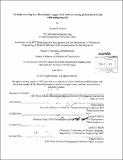| dc.contributor.advisor | Chris Caplice and Stephen Graves. | en_US |
| dc.contributor.author | Scipio, Sophia E. (Sophia Elyssia) | en_US |
| dc.contributor.other | Leaders for Global Operations Program. | en_US |
| dc.date.accessioned | 2013-10-24T17:48:45Z | |
| dc.date.available | 2013-10-24T17:48:45Z | |
| dc.date.copyright | 2013 | en_US |
| dc.date.issued | 2013 | en_US |
| dc.identifier.uri | http://hdl.handle.net/1721.1/81724 | |
| dc.description | Thesis (S.M.)--Massachusetts Institute of Technology, Dept. of Mechanical Engineering; and, (M.B.A.)--Massachusetts Institute of Technology, Sloan School of Management; in conjunction with the Leaders for Global Operations Program at MIT, 2013. | en_US |
| dc.description | Cataloged from PDF version of thesis. | en_US |
| dc.description | Includes bibliographical references (p. 80-82). | en_US |
| dc.description.abstract | This thesis explores how a retailer should determine whether to source goods domestically vs. directly by imports through international sourcing. Through the research a landed cost model was developed and designed to calculate the total landed cost of items that were shipped from overseas locations into the US. The landed cost model is different from typical models in that it integrates the physical size of the item to be imported into the total landed cost considerations. With the landed cost estimates at SKU level, the decision of whether to import or to source domestically is derived. What attributes make better import candidates over others given that a landed cost calculator outputs "yes" to import? What are some of the risks? In addition to creating a landed cost calculator, the research presents approaches around these questions. The characteristics of good import candidates are analyzed through evaluating the variables that contribute to total landed cost. Basker and Van (2008) present theories that examine the two way relationship between the size of a dominant retailer and the imports of consumer goods. They conclude that a chain needs to reach a threshold size before it begins to import. Benchmark studies of import giants like Wal-Mart are presented in this paper to understand how a longer history in the retail sector along with a robust IT infrastructure gives a company an advantage in importing retail goods. The results of this research can help retail companies with new and small import programs understand the variables that are needed to calculate total landed costs with the consideration of container utilization. Additionally it will help the retailer to decide on the best items to import in a smaller program until they can acquire economies of scale through higher import quantities. Ordering methods such as the Periodic Order Quantity Method (POQ) for fixed order periods with variable demand and Newsvendor models for advance ordering are also addressed. The results show that given several import items of varying sizes, there is an optimum region of importing which relates to COGS, size, inventory holding cost, delta of domestic to imports COGS, demand and other costs. The retailer can find this optimum region by applying analytical techniques to evaluate the candidates that are under consideration for importing. In addition to these findings, the organizational and infrastructural needs of a small imports program are addressed. The research also ties in globalization of the retail industry and the world market economy into shifts in the retailer's decisions. | en_US |
| dc.description.statementofresponsibility | by Sophia E. Scipio. | en_US |
| dc.format.extent | 82 p. | en_US |
| dc.language.iso | eng | en_US |
| dc.publisher | Massachusetts Institute of Technology | en_US |
| dc.rights | M.I.T. theses are protected by
copyright. They may be viewed from this source for any purpose, but
reproduction or distribution in any format is prohibited without written
permission. See provided URL for inquiries about permission. | en_US |
| dc.rights.uri | http://dspace.mit.edu/handle/1721.1/7582 | en_US |
| dc.subject | Mechanical Engineering. | en_US |
| dc.subject | Sloan School of Management. | en_US |
| dc.subject | Leaders for Global Operations Program. | en_US |
| dc.title | Strategic sourcing in a direct import supply chain with increasing globalization trends while mitigating risk | en_US |
| dc.type | Thesis | en_US |
| dc.description.degree | M.B.A. | en_US |
| dc.description.degree | S.M. | en_US |
| dc.contributor.department | Leaders for Global Operations Program at MIT | en_US |
| dc.contributor.department | Massachusetts Institute of Technology. Department of Mechanical Engineering | |
| dc.contributor.department | Sloan School of Management | |
| dc.identifier.oclc | 861186163 | en_US |
